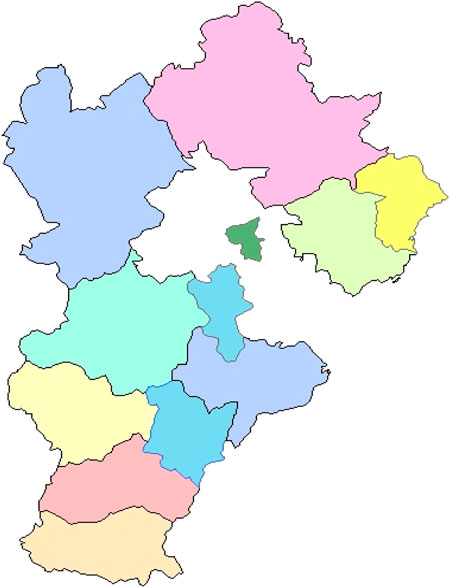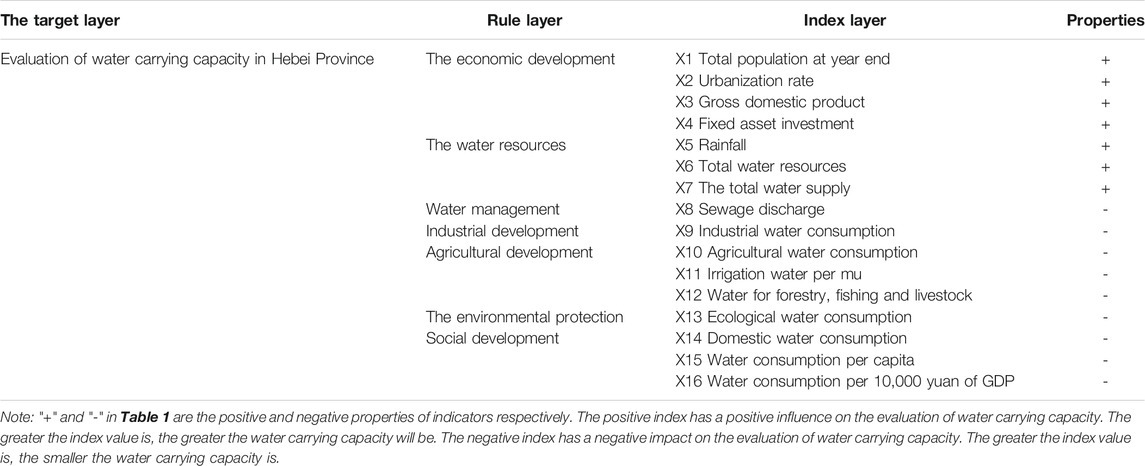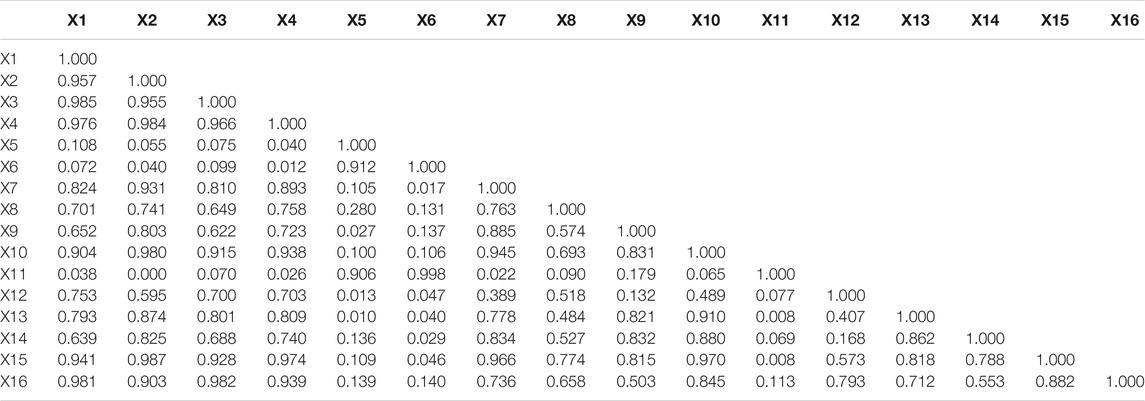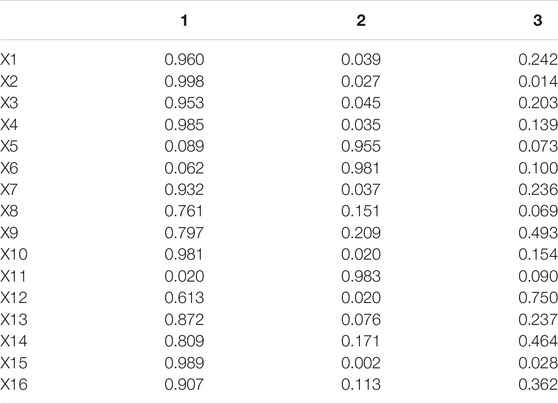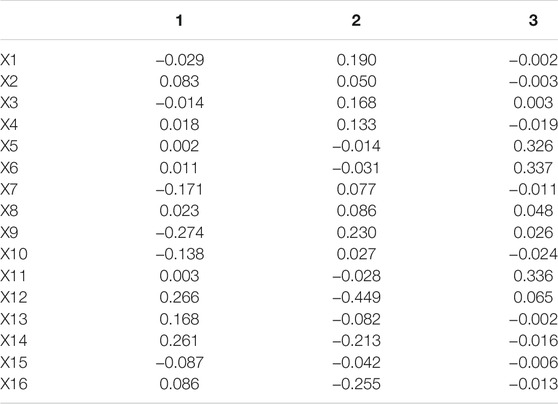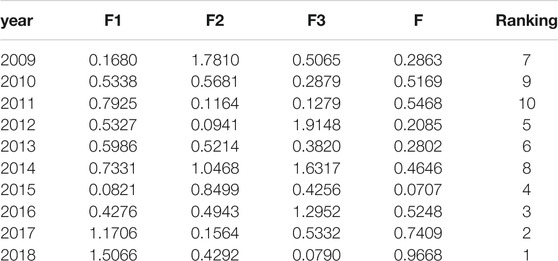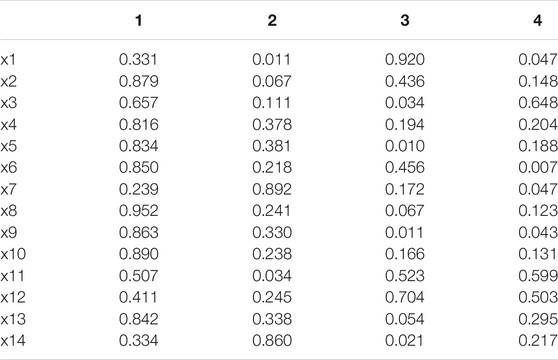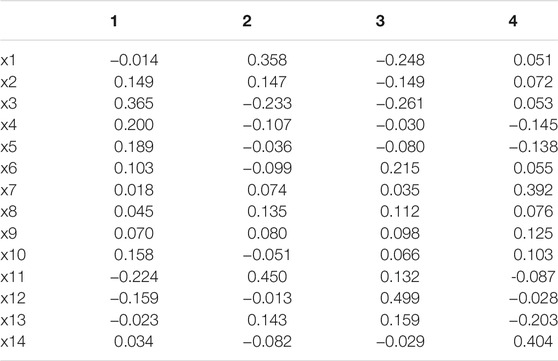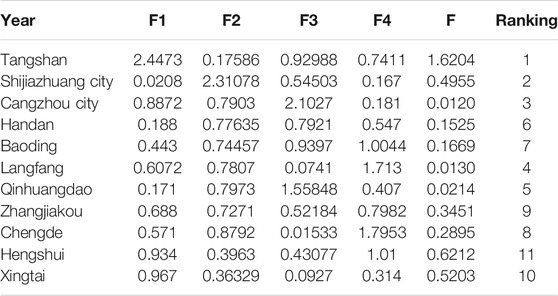- 1School of Management Engineering and Business, Hebei University of Engineering, Hebei, Handan
- 2School of Business, Chosun University, Gwangju, South Korea
- 3Faculty of Business, Economics and Accountancy, Universiti Malaysia Sabah, Kota Kinabalu, Malaysia
- 4School of Landscape and Ecological Engineering, Hebei University of Engineering, Hebei, Handan
Water is an important basic resource for social and economic development and also a necessity for the life and produce of people. The unbalanced development of water resources in Hebei Province of China and the obvious contradiction between supply and demand, affected by geography and natural environment change, has seriously influenced the Hebei village renewal process. This paper presents a comprehensive evaluation method of water carrying capacity—principal component analysis (PCA)—and constructs the evaluation index system of water carrying capacity in Hebei Province from water resources, water management, industrial development, agricultural development, social development, environmental protection, and other aspects. Based on the economic and water statistical data of Hebei province from 2009 to 2018, this paper adopts principal component analysis as an evaluation method to comprehensively evaluate the carrying capacity of water resources in Hebei Province across time and space. The results show that principal component analysis is an effective method for the comprehensive evaluation of water carrying capacity, which can reflect the local water carrying capacity objectively and comprehensively.
Introduction
Water conservancy plays an irreplaceable supporting role in implementing the rural revitalization strategy. Water is an important basic resource for social and economic development as well as a necessity for the life and produce of people. As an important component of natural resources, water resources are the key objects of ecological protection. How to measure the carrying capacity of water resources scientifically, how to predict the carrying capacity of water resources in advance, and how to provide warning for the imminent danger of water resources, are the key issues in the research of water carrying capacity.
Rural revitalization will eventually achieve comprehensive revitalization. Water plays an important role in the rural revitalization of the Beijing-Tianjin-Hebei region. Affected by the region and natural environment, the water resources in Hebei Province of China are obviously not the same in Beijing and Tianjin. In terms of quantity and structure of water, there are different degrees of quantity shortage or structure imbalance, which seriously affects the process of rural revitalization in Hebei Province. Water carrying capacity provides a new thinking and methods for the comprehensive utilization of water resources in Hebei Province. How to effectively evaluate the carrying capacity of regional water resources, reasonably develop the utilization potential of water resources, and achieve the coordinated development of the social economy and ecological environment is an important issue to be quickly solved in Hebei Province.
The study of water carrying capacity is helpful for the relevant departments to formulate water protection policies and control risks, contribute to the rational utilization of water resources, and provide water resource guarantees for rural revitalization and development in Hebei Province. The research on the carrying capacity of water resources at home and abroad is reviewed, its concept and characteristics is given, its evaluation methods are summarized and the theory of principal component analysis is elaborated upon in detail in this paper. It is an important part of examining the carrying capacity of water resources to establish its evaluation indexes. 16 evaluation indexes of water carrying capacity in Hebei province are established from the aspects of water, water management, industrial development, agricultural development, social development, and environmental protection on the basis of its influencing factors in the paper. The principal component analysis method is adopted to comprehensively evaluate the carrying capacity of the water resources of Hebei Province over time and space, and rank the carrying capacity of water resources in all regions of Hebei Province.
The rest of the paper is organized as follows: Literature review is introduced in Literature Review. The proposed method of Principal component analysis (PCA) is introduced in Methods. The case study is illustrated in Data And Case Analysis, and conclusions are discussed in Conclusion.
Literature Review
Research on the Concept of Water Carrying Capacity
At present, the research of water carrying capacity has a certain basis. The bearing capacity is a concept in mechanics, and it first appeared in the engineering field. It refers to the ability of the foundation to bear the load of buildings. Now it has been accepted and used in many fields, among which the most widely used is the study of environmental bearing capacity and resource bearing capacity in ecology. In 1921, Park and Burgess proposed the concept of ecological carrying capacity in the journal of Human Ecology. In the 1980s, UNESCO put forward the concept of carrying capacity (Nixon, et al., 2002). In 1999, United Research Service (URS Corp.)was commissioned by the United States Army Corps of Engineers and the Florida Society Office to study the carrying capacity of the Florida Keys Basin.
Taking India as an example, Joardor. (1998) studied the carrying capacity of urban water resources from the perspective of water supply, and incorporated it into urban development planning. Michiel A. Rijsberman et al. (2000) takes water carrying capacity as a measurement standard for urban water resource security.
In addition, the research on carrying capacity is more abundant in other fields. C. Bacher et al. (1997) researched ecosystem carrying capacity. Jonathan et al. (1999) researched the carrying capacity of water resources in agricultural production areas. Rees (1996) researched Urban water Supply capacity. Duarte et al. (2003) researched the Carrying capacity to coastal waters. Samuel Shephard et al. (2010) researched the Carrying Capacity of Marine ecosystems. Murray (2010) researched Population carrying capacity. Guangwei Huang (2012) has done extensive research on the carrying capacity of migratory waterfowl. France Salerno et al. (2013), based on the concept of environmental protection and sustainable development, established an environmental model to discuss the concept of tourism carrying capacity.
In China, Shi et al.(1989)first put forward the concept of the carrying capacity of water resources. Later on, Shi Yafeng (1992), Hui Yang He (2001), and Li Yunling et al. (2017) defined water carrying capacity from the maximum carrying capacity of water resources. Dictionary of Environmental Science (1991), Feng et al. (1997), Xia Jun (2002), Liu Jia-jun (2011), Duan Chunqing (2010), YANG Junfeng (2014), SUN Deliang (2018), and WANG Lili (2018) defined water carrying capacity from the maximum support scale. Xu Youpeng (1993), Gao Yanchun (1997), Hu Cheng (2013), and Song et al. (2011) defined the carrying capacity of water resources from the perspective of maximum development capacity of water resources. Tan Xiao (2018) believes that the carrying capacity of water resources is the embodiment of the sustainable development function of water resources-environment-economy-society system.
Research on the Evaluation Index System of Water Carrying Capacity
The index system of water carrying capacity is an important aspect of water carrying capacity research, but there are many factors affecting water carrying capacity, so scholars have established the evaluation index system of water carrying capacity from different perspectives.
Zhu et al. (2003) and Zhou Li (2016) established three subsystems covering water resources, ecological environment, social, and economic development. Liu et al. (2011), Zeng et al. (2013), Qu Xiao ‘e (2017), and Song et al. (2018) established an evaluation index system covering four aspects of water resources, society, economy, and ecological environment. Li et al. (2017) constructed the evaluation index system of water carrying capacity in the Yangtze River Economic Belt from four aspects: social economy, water resource quantity, water consumption, and wastewater discharge.
Research on Evaluation Methods of Water Carrying Capacity
At present, studies on the evaluation of water carrying capacity are mainly structured as follows:
Firstly, some evaluation method is used to comprehensively evaluate the index system, and then the water carrying capacity is ranked according to the evaluation results. Xu Youpeng (1993), for example, used a fuzzy comprehensive evaluation method to evaluate water carrying capacity. Fu et al. (1999) used principal component method to evaluate water carrying capacity. Zhu et al. (2003) used analytic hierarchy process to evaluate water carrying capacity. Zhou Li (2016), Huang Qiuxiang et al. (2016), Li et al. (2017), Liu et al. (2020), and Hong (2020) used principal component analysis and cluster analysis to evaluate the carrying capacity of water resources.
Secondly, some scholars established a mathematical model for quantification based on the interaction of some factors in water carrying capacity. For example, Qu Xiao ‘e (2017) made a comprehensive evaluation of the water carrying capacity of relevant regions and cities by using the comprehensive evaluation method of TOPSIS. Li Yun et al. (2017) made an empirical analysis based on the technical route and evaluation standard of water carrying capacity evaluation. Song et al. (2018) proposed the improved abrupt progression method to evaluate the water carrying capacity of five provinces and cities in the lower reaches of the Yangtze River.
Review of Literature
To sum up, scholars have carried out different degrees of research on different cities, basins or regions, but a generally accepted viewpoint has not been formed in the systematic research on the concept of water carrying capacity, and there are still shortcomings:
1) The research on the concept of water carrying capacity has not yet formed a generally accepted theoretical system.
According to the existing studies, the concept of water carrying capacity can be divided into three categories: The maximum carrying capacity of water resources, the maximum supporting scale of water resources, and the maximum development capacity of water resources. Water carrying capacity is a comprehensive concept involving many elements such as society, economy, environment, and ecology. Existing definitions from one aspect, or from several aspects, do not fully cover the subject.
2) There are a few personal subjective factors involved in the selection of evaluation indicators of water carrying capacity. Therefore, it is necessary to adopt objective methods to reduce the impact of subjective factors and determine the importance of indicators for evaluation research.
3) The evaluation method of water carrying capacity is not comprehensive enough. The existing research methods are mainly based on comprehensive evaluation, but most scholars fail to consider the influence of index weight. Especially after the rural revitalization strategy is put forward, how Hebei province integrates the water resources of Beijing, Tianjin, and Hebei, is particularly important to the development of Hebei Province, but there is a lack of research on this aspect.
Methods
From the previous research results, the evaluation methods of water carrying capacity mainly include supply-demand balance method, analytic hierarchy process, fuzzy comprehensive evaluation method, principal component analysis method, systematic dynamic method, etc. In this paper, principal component analysis (PCA) is used to evaluate the carrying capacity of water resources in Hebei province. Principal component analysis (PCA) is an independent statistical analysis method that uses a small number of indicators to represent majority variable indicators and reflects the information reflected by majority variable indicators as much as possible through dimension reduction (France Salerno et al., 2013). The specific calculation steps are as follows.
Step1: In order to eliminate the impact of errors caused by order of magnitude and dimension, the original data are standardized.
Step2: Calculate the correlation coefficient matrix of the standardized samples.
Step3: Calculate eigenvalues and eigenvectors.
Step4: Calculate the contribution rate of principal component and the cumulative contribution rate. Under normal circumstances, determine the main component with the cumulative contribution rate greater than or equal to 85%.
Step5: Calculate principal component load.
U1 is called the first principal component, U2 is called the second principal component, and Up is called the pth principal component.
Step6: Calculate comprehensive score and conduct comprehensive evaluation on regional water carrying capacity.
Data and Case Analysis
Study Area Status and Data Sources
Hebei is located between longitude 113°27′ and 119°50′ east and latitude 36°05′ and 42°40′ north. It is located in North China, north of Zhanghe river, east of Bohai Sea and inner Ring of Beijing and Tianjin, west of Taihang Mountain, North of Yanshan Mountain, North of Yanshan is Zhangbei Plateau and the rest is Hebei plain (As shown in Figure 1). It is the only province in China that has plateaus, mountains, hills, plains, lakes, and seashores. Hebei province covers an area of 188,800 square kilometers and has a permanent resident population of 75, 919, 700. It has jurisdiction over 11 prefecture-level cities, including Shijiazhuang city, Tangshan city, Handan city, Cangzhou city, Baoding city, Langfang city, Qinhuangdao city, Zhangjiakou city, Chengde city, Hengshui city, and Xingtai city. It has a temperate continental monsoon climate, and most of the four seasons are distinct.
The data used in this study are from Statistical Yearbook of Hebei Province and Hebei Water Resources Bulletin (2009‐2018) which are calculated and sorted out.
Establish the Evaluation Index System
It can be seen from the definition of water carrying capacity that it is a comprehensive concept involving many factors such as society, economy, environment, ecology, etc. Therefore, in the evaluation and analysis of regional water carrying capacity, the selection of appropriate indicators should also involve several factors.
This article is based on the summary and reflection of the water carrying capacity system. According to the actual situation of Hebei Province, 16 factors were selected from the aspects of water resources, water management, industrial development, agricultural development, social development, and environmental protection to comprehensively evaluate the water carrying capacity of Hebei province from 2009 to 2018, as shown in Table 1.
Because Hebei province straddles Beijing and Tianjin, and has plateaus, mountains, hills, plains, lakes, and seashores, the distribution of water resources is inevitably uneven, which makes the water resources ineffectively used. In order to better understand the carrying capacity of water resources in Hebei Province, 11 cities in Hebei Province were also evaluated in this paper. Combined with the actual situation, the evaluation index system includes X1 (The total population at the end of the year), X2 (Gross regional product), X3 (Per capita GDP), X4 (Per capita disposable income of urban residents), X5 (Per capita net income of farmers), X6 (Per capita water consumption), X7 (Total water resources), X8 (Total water supply), X9 (Industrial water consumption), X10 (Agricultural water consumption), X11 (Urban environmental water consumption), X12 (Water consumption per 10,000 yuan of GDP), X13 (Development and utilization rate of water resources), and X14 (Rainfall).
Principal Component Analysis of Water Carrying Capacity in Hebei Province
The data of 16 factors reflecting the water carrying capacity of Hebei Province from 2009 to 2018 are shown in Table 2. The data in Table 2 were standardized by SPSS25, and then the standardized data were analyzed by principal component analysis. The correlation coefficient matrix of the impact factors of water carrying capacity (Table 3) and the eigenvalue and contribution rate of principal components (Table 4) can be obtained.
As can be seen from Table 3, there is a certain correlation between the 16 factors. X1With X2, X3, X4 has a strong positive correlation, and with X10、X15, X16 has a negative correlation; X2With X3, X4 has a strong positive correlation, and with X10, X15 has a negative correlation; X3With X4 has a strong positive correlation, and with X15, X16 has a negative correlation; X4With X10, X14, X15 has a negative correlation; X5With X6, X11 has a strong positive correlation. X6With X11 has a strong positive correlation. X7With X10\X15 has a strong positive correlation. These explain the rationality of principal component analysis.
As can be seen from Table 4, the cumulative contribution rate of the first three principal components reaches 92.776%, which can be considered as the main factor affecting the water carrying capacity. Therefore, the first, second, and third principal components are selected to analyze the water carrying capacity of Hebei Province, and the loads of each variable on the first, second, and third principal components are calculated.
As can be seen from Table 5, the first principal component has a strong statistical significance with X1, X2, X3, and X4, and is negatively correlated withX7, X15, and X16. This shows that the population and social and economic development level are the main factors affecting the carrying capacity of water resources in Hebei Province. The total population of Hebei increased from 70, 344, 000 in 2009 to 755,563,000 in 2018. With the increase of population, the demand for water resources also gradually increased, and the contradiction between water resources supply and demand intensified. Hebei’s GDP in 2018 was 360.03 billion yuan, 111.49 % higher than 1702.66 billion yuan in 2009. Investment in fixed assets was 3.53109 trillion yuan in 2018, an increase of 186.84 percent over the 123.05 billion yuan in 2009. At the same time, with the rapid development of social economy, the consumption of water resources is increased, and the carrying capacity of water resources is under great pressure.
The second principal component and the third principal component have a strong positive correlation with X5, X6, X11, and X13, mainly reflecting the natural status of water resources. Hebei province is a big agricultural province with a large amount of agricultural water consumption. However, Hebei province is located in the semi-arid region of North China and is inherently deficient in water resources. In 2009, the total amount of water resources was 14.116 billion m3. In 2012, the best year, the total water resources was 23.553 billion m3, the total amount of water resources varies greatly from year to year, thus affecting the stability of the water carrying capacity.
Through factor analysis, the component scoring coefficient matrix (factor scoring coefficient) is obtained. Table 6 lists the coefficient vectors of standardized variables in the analytical expressions of the three main components. We can write the expression of common factors (F1, F2, and F3 represent the three common factors, and ZX1∼ZX6 respectively, represent the variables after the standard normal transformation):
F1= -0.029*ZX1+0.083*ZX2-0.014*ZX3+0.018*ZX4+0.002*ZX5+0.011*ZX6-0.171*ZX7+0.023*ZX8-0.274*ZX9-0.138*ZX10+0.003*ZX11+0.266*ZX12+0.168*ZX13+0.261*ZX14-0.087*ZX15+0.086*ZX16
Same thing with F2 and F3.
According to the formula, the comprehensive score of the water carrying capacity of Hebei Province can be obtained (see Table 7). The positive score means that the value is higher than the average level at the time of the study, while the negative score means that the value is lower than the average level. The larger the comprehensive score value is, the stronger the carrying capacity of water resources is, and conversely, the weaker the carrying capacity is.
As can be seen from Table 7, with the passage of time, the carrying capacity of water resources in Hebei province presents an increasing trend year by year, this is mainly due to the advancement of urbanization, the increase in Gross Domestic Product (GDP) and population, consumption, and increasing demand for water matched by increased water use efficiency and the ability to deal with sewage gradually, in addition, the constant improvement of the consciousness of water-saving among people, to some extent, also can improve the bearing capacity of water resources.
Comparative Analysis of Water Carrying Capacity of Various Cities in Hebei Province
Due to the serious uneven spatial and temporal distribution of water resources in Hebei Province, this uneven distribution has further reduced the effective supply of water resources. In order to better understand the carrying capacity of water resources in Hebei Province, this paper also selected the average data of the cities in Hebei province in the past 10 years, and compared and analyzed the differences of carrying capacity of water resources among cities in Hebei Province. The selected index system includes X1 (total population at year end), X2 (GDP), x3 (Per capita GDP), x4 (The per capita disposable income of urban residents), X5 (The farmers’ average net income), X6 (Per capita water consumption), X7 (Total water resources), X8 (Total water supply), X9 (Industrial water consumption), X10 (Agricultural water consumption), X11 (Urban environmental water consumption), X12 (Water consumption per 10,000 yuan OF GDP), X13 (Development and utilization rate of water resources), X14 (rainfall). The original data of different regions from 2009 to 2018 are shown in Table 8.
It can be seen from Table 9, the cumulative contribution rate of the first four principal components reached 91.454%. This can be considered as the main factor affecting the carrying capacity of water resources. Therefore, the first, second, third and fourth principal components are selected to analyze the carrying capacity of water resources in all regions of Hebei province, and the loads of each variable on the first, second, third and fourth principal components are calculated.

TABLE 9. Characteristic values and contribution rates of principal components in each region of Hebei Province.
As it can be seen from Table 10, there is a strong positive correlation between x2、x8、x9、x10, indicating that agricultural, social, and economic development level are the main factors affecting the water carrying capacity of all cities in Hebei Province. The development of cities in Hebei province is based on agriculture, and agricultural development consumes large amounts of water resources and causes great pressure on the carrying capacity of water supply resources. The second principal component has a strong positive correlation with x7 and x14. There is a strong positive correlation between the third principal component and x1.
Through factor analysis, it is concluded that component score coefficient matrix (coefficient of factor score), Table 11 lists the four main composition analytic expressions of the standardized variable coefficient vector, we can write a common factor expression (F1, F2, F3, and F4 represent four common factors, ZX1∼ZX14 represent the standard normal after the transformation of variables):
F1= -0.014*ZX1+0.149*ZX2+0.365*ZX3+0.200*ZX4+0.189*ZX5+0.103*ZX6+0.018*ZX7+0.045*ZX8+0.070*ZX9+0.158*ZX10-0.224*ZX11-0.159*ZX12-0.023*ZX13+0.034*ZX14
Same thing with F2、F3, and F4.
According to the formula and principal component calculation, the comprehensive score of water carrying capacity in Hebei province can be obtained (see Table 12). The positive score means that the value is higher than the average level at the time of the study, while the negative score means that the value is lower than the average level. The larger the comprehensive score value is, the stronger the carrying capacity of water resources is, and conversely, the smaller the comprehensice score value is, the weaker the carrying capacity is.
On the whole, Tangshan, Cangzhou, Langfang, Shijiazhuang, and other regions with relatively high economic development have relatively large industrial water consumption. However, with the reform of industrial technology, industrial water is reused, which reduces the industrial water consumption. Moreover, with the deepening of air pollution prevention and control, the government requires large water users such as metal smelters and chemical raw material manufacturers to stop production. The stronger their water resources development and utilization capacity is, the larger their water carrying capacity is.
Chengde city, Zhangjiakou city, and Baoding city are located in the vast Bashang grassland, with insufficient regional resources, but abundant precipitation, and the total water resources are in the forefront of the province. Their economic level of the province is in the middle level, but the development is strong and the demand for water resources is also large, so the carrying capacity of water resources is in the middle level. Due to the serious shortage of natural water resources, the total water resources and precipitation of Xingtai city and Hengshui city are relatively low, and the comprehensive score of water resources carrying capacity is relatively low.
Conclusion
1) Human activities are the main factors of water carrying capacity change in Hebei Province.
In recent years, the total amount of water resources in Hebei Province is gradually expanding, but the population is increasing year by year, the amount of water resources per capita is decreasing, and the water consumption per capita is increasing year by year. According to the change trend of water resources in Hebei Province from 2009 to 2018 and the water carrying capacity of various cities in Hebei Province, the total population, urbanization rate, GDP and fixed asset investment are the main factors affecting the water carrying capacity in Hebei Province. With the expansion of human activities and the development of the social economy to a certain stage, production activities and living behaviors have a great impact on the water environment, which is mainly manifested in the reduction of total water resources, large water consumption and serious water pollution.
2) The carrying capacity of water resources in Hebei Province showed a good trend.
According to the data analysis from 2009 to 2018, the water carrying capacity grade of Hebei Province is basically developing towards a good trend, and the carrying capacity of water resources is gradually improving. However, with the development of the social economy and the acceleration of urbanization, the contradiction between supply and demand of water resources will become increasingly prominent, and the comprehensive utilization of water resources should be strengthened.
3) There are differences in the carrying capacity of water resources in 11 cities of Hebei Province
Under the influence of natural conditions and policy factors, the carrying capacity of water resources in the eastern part of Hebei is higher than that in the northern and southern parts. During the 13th Five-Year Plan period, the measures on water resource environment optimization issued by the government are positive and effective. During the 14th Five-Year Plan period, it is necessary to continue to maintain a good momentum of development, introduce measures to boost the carrying capacity of water resources in various regions of Hebei, and narrow the differences between regions.
Data Availability Statement
The original contributions presented in the study are included in the article/Supplementary Material, further inquiries can be directed to the corresponding author.
Author Contributions
HW: Data curation, Investigation, Methodology, Project administration, Formal analysis, Resources, Validation, Visualization, Editing. YX:Writing-original draft. RS: Conceptualization. HM: Supervision. LW: Funding acquisition.
Conflict of Interest
The authors declare that the research was conducted in the absence of any commercial or financial relationships that could be construed as a potential conflict of interest.
Publisher’s Note
All claims expressed in this article are solely those of the authors and do not necessarily represent those of their affiliated organizations, or those of the publisher, the editors, and the reviewers. Any product that may be evaluated in this article, or claim that may be made by its manufacturer, is not guaranteed or endorsed by the publisher.
Acknowledgments
The relevant research is supported by 2019 Hebei Provincial Social Science Fund project (subject No: HB19GL062), 2019 Handan Science and Technology Bureau project (Subject No: 19422303008–71), 2018 Hebei Provincial Water Ecological Civilization and Social Governance Research Center Project (Subject No: 2018SZX7).
References
Bacher, C., Duarte, P., and Ferreira, J. G. (1997). Assessment and Comparison of the Marennes-Oléron Bay (France) and Carlingford Lough (Ireland) Carrying Capacity with Ecosystem Models. Aquat. Ecol. 31, 379–394. doi:10.1023/A:1009925228308
Duarte, P., Meneses, R., and Hawkins, A. J. S. (2003). Mathematical Modelling to Measure the Carrying Capacity for Mufti-Species Culture within Coastal Waters. Ecol. Model. doi:10.1016/S0304-3800(03)00205-9
Hong, X. (2020). Analysis of Water Resources Carrying Capacity in Xinjiang Based on Principal Component Analysis. Water Resour. Plann. Des. 9, 39–41+60. doi:10.3969/j.issn.1672-2469.2020.09.010
Joardar, S. D. (1998). Carrying Capacities and Standards as Bases towards Urban Infrastructure Planning in India: A Case of Urban Water Supply and Sanitation. Plann. IndiaHabitat Intl 22, 327–337. doi:10.1016/S0197-3975(98)00002-2
Murray, L. (2010). The Carrying Capacity Imperative: Assessing Regional Carrying Capacity Methodologies for Sustainable Land-Use Planning. Florida: Land use Policy. doi:10.1016/j.landusepol.2010.01.006
Nixon, S. W., Dalrymple, G. H., Deyle, R. E., Huber, W. C., Peterson, M. S., Polasky, S., et al. (2002). A Review of the Florida Keys Carrying Capacity studyCommittee to Review the Florida Keys Carrying Capacity Study. Florida: National Academy Press. http://www.nap.edu/books/030908346X/html.
Rees, William. E. (1996). Revisiting Carrying Capacity: Area-Based Indicators of Sustainability[J]. Popul. Environ. 17 (3), 195–215. doi:10.1007/BF02208489
Rijsberman, M. A., Frans, H., and van de Ven, M. (2000). Different Approaches to Assessment of Design and Management of Sustainable Urban Water Systems. Delft: Environment Impact Assessment Review, 333–345. doi:10.1016/S0195-9255(00)00045-7
Salerno, F., Viviano, G., and Manfredi, E. C., (2013). Multiple Carrying Capacities from a Management-Oriented Perspective to Operationalize Sustainable Tourism in Protected Areas. J. Environ. Manage., 116–125. doi:10.1016/j.jenvman.2013.04.043
Shephard, S., Brophy, D., and David, G. (2010). Reid, Can Bottom Trawling Indirectly Diminish Carrying Capacity in a marine Ecosystem? Mar. Biol., 2375–2381. doi:10.1007/s00227-010-1502-9
Keywords: principal component analysis, water carrying capacity, comprehensive evaluation, hebei province, natural environment change
Citation: Wang H, Xu Y, Suryati Sulong R, Ma H and Wu L (2021) Comprehensive Evaluation of Water Carrying Capacity in Hebei Province, China on Principal Component Analysis. Front. Environ. Sci. 9:761058. doi: 10.3389/fenvs.2021.761058
Received: 19 August 2021; Accepted: 24 September 2021;
Published: 22 October 2021.
Edited by:
Wendong Yang, Shandong University of Finance and Economics, ChinaReviewed by:
Yaoyao He, Hefei University of Technology, ChinaWang Jiefang, North China University of Water Conservancy and Electric Power, China
Yingjie Yang, De Montfort University, United Kingdom
Copyright © 2021 Wang, Xu, Suryati Sulong, Ma and Wu. This is an open-access article distributed under the terms of the Creative Commons Attribution License (CC BY). The use, distribution or reproduction in other forums is permitted, provided the original author(s) and the copyright owner(s) are credited and that the original publication in this journal is cited, in accordance with accepted academic practice. No use, distribution or reproduction is permitted which does not comply with these terms.
*Correspondence: Lifeng Wu, d2xmNjY2NkAxMjYuY29t
 Huadong Wang1,2
Huadong Wang1,2 Lifeng Wu
Lifeng Wu